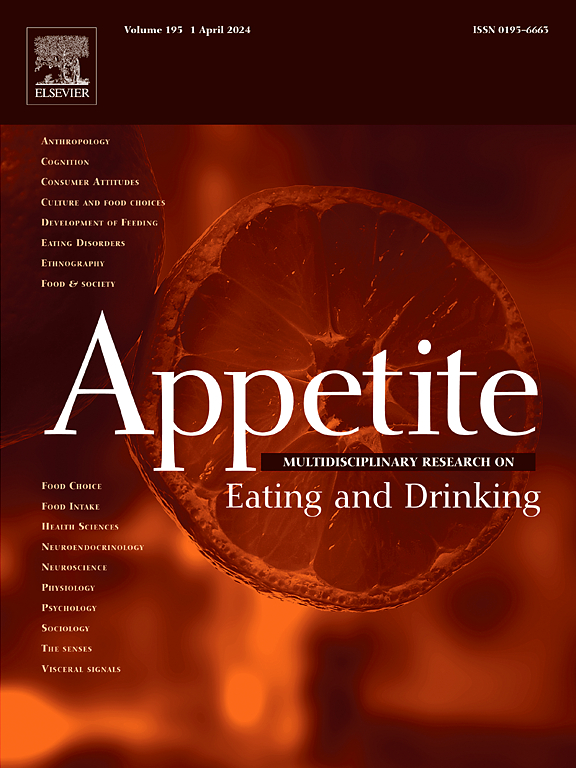食物不安全和食物成瘾共同发生的生活经验:一项定性研究。
IF 4.6
2区 医学
Q1 BEHAVIORAL SCIENCES
引用次数: 0
摘要
家庭粮食不安全影响了13.5%的美国家庭,并与短期和长期的负面健康结果有关。食物成瘾症认为,高度加工的食物可能会引发类似于物质使用障碍(SUD)的成瘾反应,大约15%的成年人患有这种疾病。食物成瘾是使用耶鲁食物成瘾量表(YFAS) 2.0来测量的,该量表基于精神疾病诊断与统计手册第五版中概述的SUD标准。虽然最近的研究表明,粮食不安全和食物成瘾在低收入成年人中存在关联,但经历粮食不安全和食物成瘾的成年人的生活经历需要进一步研究。对有食物不安全和食物成瘾的成年人(n=23)进行了定性访谈,以调查他们的生活经历,以及食物不安全如何影响参与者的食物成瘾经历,是促进还是加剧了食物成瘾症状,还是促成了与食物成瘾不一致的其他经历。总体而言,参与者对每种症状的描述反映了对食物成瘾成年人更一般样本的描述。例如,主题包括强迫性HP食物消费,尽管有负面后果和对HP食物的强烈渴望。虽然大多数参与者没有明确地将他们的粮食不安全和食物成瘾的经历联系起来,但出现了几个与粮食不安全导致食物成瘾症状有关的主题,包括在有HP食品时倾向于过量食用,过量食用以避免食物浪费,以及当经济拮据限制获得HP食品时出现戒断症状。总之,经历食物不安全的个体以与更一般的食物成瘾成年人样本一致的方式描述了他们的食物成瘾经历,并强调了食物不安全如何导致几种食物成瘾症状。本文章由计算机程序翻译,如有差异,请以英文原文为准。
The lived experience of Co-occurring food insecurity and food addiction: A qualitative study
Household food insecurity affects 13.5% of US households and is associated with short and long-term negative health outcomes. Food addiction, which posits that highly processed (HP) foods may trigger addictive responses akin to substance use disorders (SUD), occurs in approximately 15% of adults. Food addiction is measured using the Yale Food Addiction Scale 2.0, which is based on the SUD criteria outlined in the Diagnostic and Statistical Manual of Mental Disorders, Fifth Edition. Although recent research suggests food insecurity and food addiction are associated among low-income adults, the lived experience of adults experiencing food insecurity and food addiction requires further study. Qualitative interviews were conducted with adults (n = 23) with food insecurity and food addiction to investigate their lived experience and how food insecurity impacted participants’ experiences of food addiction, whether to facilitate or intensify food addiction symptoms, or contribute to other experiences inconsistent with food addiction. Overall, participant descriptions of each symptom mirrored descriptions from more general samples of adults with food addiction. For example, themes included compulsive HP food consumption despite negative consequences and intense craving for HP food. Although most participants did not explicitly connect their experiences of food insecurity and food addiction, several themes emerged related to food insecurity contributing to food addiction symptoms, including a tendency to overeat HP foods when they became available, overeating to avoid food waste, and withdrawal symptoms emerging when financial constraints limited access to HP food. In sum, individuals experiencing food insecurity described their food addiction experiences in ways consistent with more general samples of adults with food addiction and highlighted how food insecurity contributed to several food addiction symptoms.
求助全文
通过发布文献求助,成功后即可免费获取论文全文。
去求助
来源期刊

Appetite
医学-行为科学
CiteScore
9.10
自引率
11.10%
发文量
566
审稿时长
13.4 weeks
期刊介绍:
Appetite is an international research journal specializing in cultural, social, psychological, sensory and physiological influences on the selection and intake of foods and drinks. It covers normal and disordered eating and drinking and welcomes studies of both human and non-human animal behaviour toward food. Appetite publishes research reports, reviews and commentaries. Thematic special issues appear regularly. From time to time the journal carries abstracts from professional meetings. Submissions to Appetite are expected to be based primarily on observations directly related to the selection and intake of foods and drinks; papers that are primarily focused on topics such as nutrition or obesity will not be considered unless they specifically make a novel scientific contribution to the understanding of appetite in line with the journal's aims and scope.
 求助内容:
求助内容: 应助结果提醒方式:
应助结果提醒方式:


